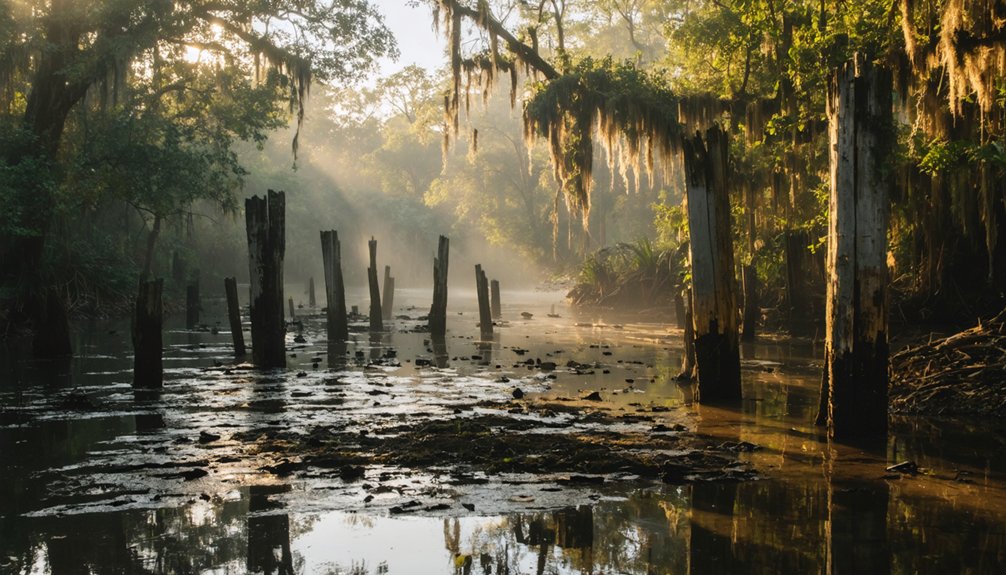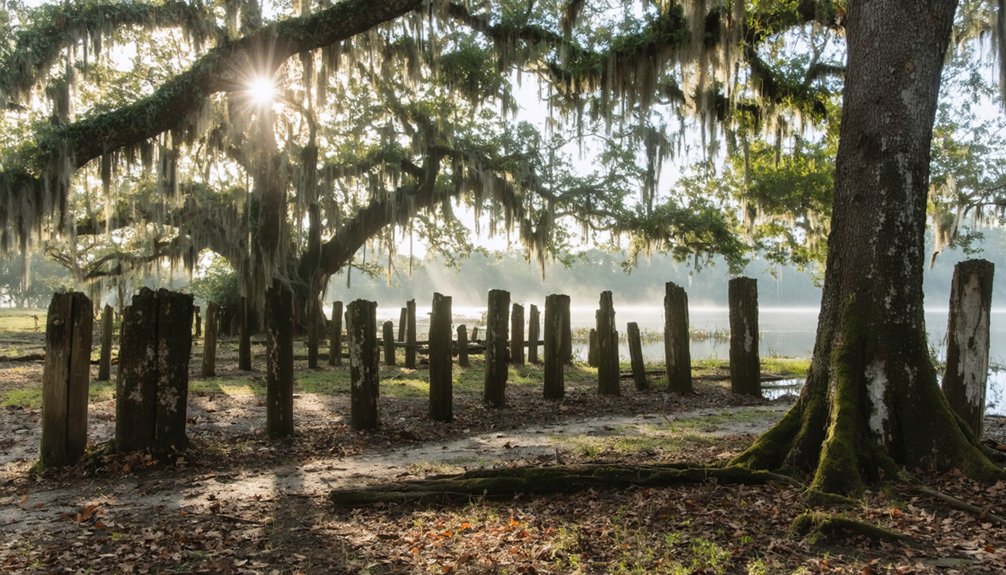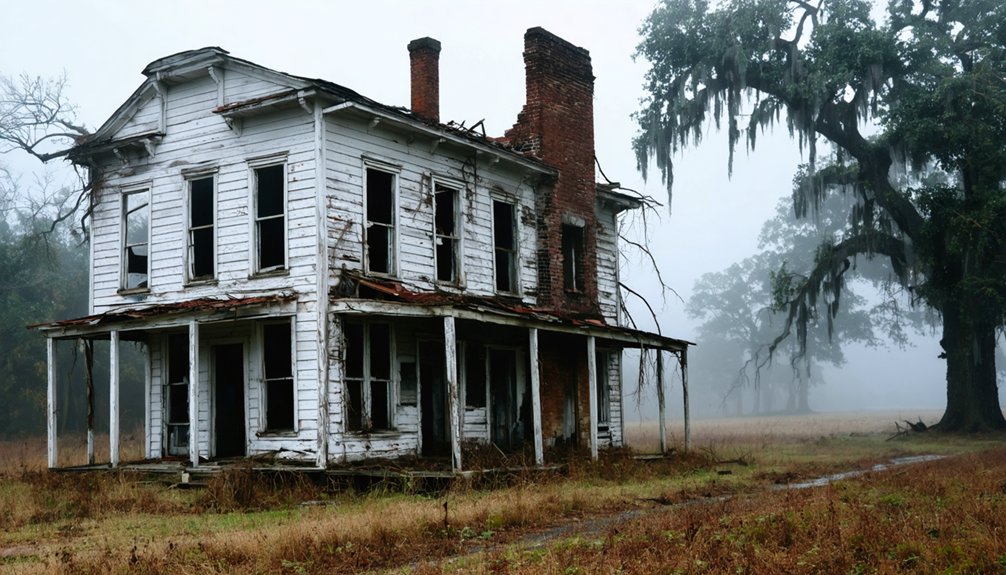You’ll discover Oketeyeconne as a former Creek settlement that flourished along Georgia’s Chattahoochee River in the 1700s. Under Chief James Perryman‘s leadership, this independent community featured a central town square, communal gardens, and four council cabins where residents practiced sacred ceremonies like the Green Corn Feast. Though mounting pressures from white settlers forced its abandonment in the early 1800s, archaeological findings continue to reveal the rich cultural heritage of this resilient Native American town.
Key Takeaways
- Oketeyeconne was a Native American settlement on Georgia’s Chattahoochee River that became abandoned following conflicts with white settlers in the 1800s.
- The town featured wooden houses, storehouses, and meeting pavilions centered around a town square with four council cabins.
- Originally established as a refuge for Itsate people fleeing Cherokee expansion, the settlement maintained independence by rejecting Creek treaties.
- The community practiced mixed farming with corn and rice fields, while maintaining strong cultural traditions through ceremonies and gatherings.
- Archaeological evidence in the Chattahoochee River Valley reveals details about the town’s layout and agricultural practices before its abandonment.
The Origins of Oketeyeconne Along the Chattahoochee
While many Creek settlements dotted the Chattahoochee River’s landscape in the 1700s, Oketeyeconne emerged as a unique refuge when Itsate people fled from the expanding Cherokee presence in the North Carolina and Georgia Mountains.
You’ll find this settlement’s rich Oketeyeconne heritage reflected in its strategic position on the east bank of the river, just south of Sandy Creek. The town maintained its independence by bridging cultural divides – connecting with Muskogee-speaking Creeks to the north and Hitchiti-speaking communities to the south. Under the leadership of James Perryman as chief, the community thrived and cultivated extensive agricultural lands.
Despite pressure to conform to Creek traditions, Oketeyeconne charted its own path, refusing to comply with the Creek treaties of 1827 and 1832, highlighting its distinct status as an autonomous enclave rather than a formal Creek Confederacy member. The town was eventually submerged underwater during the creation of Walter F. George Lake.
Life in an 18th Century Creek Settlement
If you’d visited Oketeyeconne in the 1700s, you’d have seen villagers starting their day at sunrise with communal activities centered around the town square, where micos led important discussions and ceremonial gatherings.
Throughout the day, women tended communal gardens and prepared meals at central hearths, while men engaged in hunting or trading deerskins with European merchants along the Chattahoochee River. These trading activities became so profitable that tens of thousands of deerskins were exported annually to English factories through major ports like Savannah. The bustling port cities resembled their British counterparts, where horse-drawn carriages transported goods along unpaved streets.
Sacred burial grounds lay separate from the living areas, where the Creek people carefully interred their deceased in earthen mounds following traditional rituals that included placing cherished possessions alongside the departed.
Daily Village Activities
As the sun rose over Oketeyeconne, the Creek settlement bustled with daily activities centered around its compact layout of wooden houses, storehouses, and meeting pavilions.
You’d find women tending to crops in the surrounding fields while others prepared meals in the communal cookhouses using both traditional and European traded goods.
- Men ventured into forests for deerskin hunting, bringing back tens of thousands of pelts annually to trade for cloth, kettles, and guns.
- Families gathered around hearths for warmth and cooking, using metal pots alongside traditional pottery.
- Women preserved food through smoking and drying techniques, storing provisions for ceremonies and winter months.
- Children learned essential skills as they watched their elders manage livestock, process harvests, and maintain the village’s structures.
Following the Spanish Catholic missions’ establishment along the coast in the late 1500s, some Creek settlements adopted new farming techniques and crop varieties introduced by the missionaries.
The increasing engagement with white settlers led to deep social divisions between wealthy and poor Creek families as some gained more access to European trade goods.
Sacred Burial Traditions
When death came to Oketeyeconne, sacred burial traditions guided the community through their loss. The burial customs began with a three to four-day waiting period, allowing family and friends to gather.
You’d witness the body being prepared using natural materials like yucca for washing, and sometimes red ochre would be applied as a symbol of life. Like many Native American tribes, they viewed death as a natural cycle and an important transition between physical and spiritual realms.
The mourning practices involved the entire community. You’d hear the tolling of a large bell as the funeral procession made its way to the burial site, located away from the village’s living spaces.
The graves were carefully prepared, often lined with tree bark and wooden boards before being covered with earth. Personal possessions, tools, and ceremonial items would accompany the deceased, reflecting their journey into the spirit world. These sacred burial goods were considered essential elements of their spiritual beliefs and cultural practices.
Sacred Burial Traditions and Spiritual Practices
The sacred burial practices of Native American tribes around Oketeyeconne revealed deep spiritual connections to both land and ancestors. Their burial customs honored the deep bond between the living and departed through earth burials, cremation, and elevated platforms that returned the deceased to nature’s embrace. Modern verification methods help ensure user identity protection when documenting these historical sacred sites. The Mississippian culture constructed elaborate burial mounds as ceremonial centers for their communities.
- Warriors’ graves were considered untouchable, protected by an unwritten code of honor that transcended tribal conflicts.
- Sacred ceremonies included washing the departed with yucca and adorning them with symbolic feathers.
- Multi-day mourning periods strengthened community bonds while preparing the deceased for their spiritual journey.
- Blankets held deep meaning in funeral rites, especially among the Seminole and Choctaw peoples, symbolizing protection and resilience.
Today, these sacred traditions are protected by law, preserving the ancestral connections to burial grounds that once dotted the Georgia landscape.
The Green Corn Feast and Cultural Ceremonies
At Oketeyeconne’s annual Green Corn Feast, you’d witness the sacred cleansing ritual where tribal members gathered to drink the “Black Drink” and extinguish all old fires in preparation for renewal.
You’d observe how the ripening of corn in late June or early July marked not only the harvest celebration but also the tribe’s New Year, accompanied by prayers and thanksgiving rites.
When new ceremonial fires were brought down to the village, you’d see them symbolically restore balance and harmony as the community united in dancing, feasting, and spiritual observances that could last up to eight days.
Sacred Cleansing Rituals
During the peak of summer harvest, indigenous peoples of Oketeyeconne gathered annually for the sacred Green Corn Ceremony – a profound ritual of physical and spiritual cleansing that marked their New Year celebration.
The ceremony’s intensive purification practices reflected their deep commitment to community purification and spiritual renewal.
- You’d witness traditional healers administering herbal purgatives to cleanse both body and spirit.
- You’d observe separate bathing rituals for men and women using sacred herbal solutions.
- You’d experience the spiritual intensity of day-long fasting periods.
- You’d join the communal feast that broke the fast, uniting the people in celebration.
After completing these sacred rituals, participants emerged renewed, their bodies and spirits purified for the coming agricultural cycle.
The cleansing ceremonies reinforced the interconnectedness of individual, community, and environmental well-being.
New Fire Ceremonies
Sacred flames marked the commencement of Oketeyeconne’s Green Corn Ceremony, as tribal members gathered to witness their spiritual leader kindle a new ceremonial fire that would unite and purify the community.
In silence, you’d watch as the spiritual leader ignited the sacred flames, marking the start of spiritual renewal for all present.
The fire’s ceremonial significance extended beyond its immediate presence, as you’d carry its flames back to rekindle your household hearth.
Around this central fire, you’d join others in prayer and traditional stomp dances, while old possessions were burned as offerings.
The fire ceremony served as a powerful symbol of rebirth, purifying both individual spirits and strengthening communal bonds as participants gathered to share in this sacred tradition of renewal.
Corn Ripening Celebrations
When summer’s ripening corn signaled nature’s abundance, Oketeyeconne’s residents would gather for the Green Corn Ceremony – their most significant annual celebration.
You’d find the community preparing for days, cleaning their homes and gathering materials for the harvest rituals. The corn symbolism ran deep through every aspect, from prayers to feasting.
- The ceremony began with fasting and purification, cleansing both body and spirit.
- Stomp dances filled the air with rhythmic sounds of turtle shell rattles.
- Sacred fires were extinguished and relit, marking renewal and new beginnings.
- Communal feasts celebrated the Three Sisters – corn, beans, and squash.
The ceremonies strengthened community bonds while honoring ancestral traditions.
Local elders led these sacred rituals, ensuring their cultural heritage endured through generations in this Creek settlement.
Daily Life and Social Structure
At the heart of Oketeyeconne stood a central square flanked by four council cabins, forming the village’s social and political nucleus. You’d find community gatherings here regularly, where elders and chiefs made important decisions affecting daily life.
The layout promoted social cohesion, with living quarters arranged around this essential core. Life centered around mixed farming – you’d see fields of corn and rice alongside grazing cattle, horses, and hogs.
The village’s leadership consisted of a council of elders and a chief, representing the Hitchiti-speaking Lower Creeks. Though independent from the Creek Confederacy, they maintained connections with both Muskogee Creeks and Hitchiti towns.
The population grew diverse over time as different Creek branches sought refuge here, creating a unique cultural blend.
Warrior Culture and Resistance

You’ll find Oketeyeconne’s warrior culture centered on a blend of traditional Creek battle tactics and sacred war rituals, with warriors training extensively in guerrilla warfare and quick-strike maneuvers along the Chattahoochee River.
The town’s fighters maintained their martial spirit through ceremonies like the Green Corn Feast, where they’d perform cleansing rites to strengthen their combat resolve and buried weapons with fallen warriors as symbols of eternal resistance.
Even as American forces pressed their advantage with fortifications like Fort Gaines, Oketeyeconne’s warriors refused to submit, instead forming strategic alliances with British forces and fellow Creek-Seminole groups while adapting their resistance tactics to survive.
Battle Tactics and Training
Throughout their resistance against American expansion, Oketeyeconne warriors developed sophisticated battle tactics that combined traditional Creek warfare with adaptive strategies. Their warrior training emphasized physical endurance and tactical maneuvers, preparing fighters to strike swiftly and retreat strategically through the challenging terrain near the Chattahoochee River.
- You’d find warriors mastering both traditional weapons and modern firearms, adapting their arsenal to match the evolving threats.
- They’d utilize the region’s landscape, particularly near Sandy Creek, for guerrilla-style ambushes.
- Their alliance with Miccosukee and Seminole fighters strengthened their resistance capabilities.
- They’d maintain a robust intelligence network, tracking enemy movements through their intimate knowledge of local geography.
The warriors integrated these combat skills with their community roles, participating in agricultural activities when not engaged in defense operations.
Sacred War Rituals
Sacred war rituals formed the spiritual foundation of Oketeyeconne’s resistance culture, with the Green Corn Feast (“Boosketah”) serving as their most significant ceremonial gathering.
During these ceremonies, you’d witness the ritual significance of the “Black Drink” purification process, where council members prepared themselves for critical war decisions. The community unity manifested through collective fasting practices and the symbolic renewal of extinguishing old fires to kindle new ones.
Your warrior ethos would connect deeply to ancestral spirits through distinct burial customs, where fallen warriors rested beneath home beds with their weapons, ready for spiritual warfare in the afterlife.
This cultural resilience sustained Oketeyeconne’s resistance even after displacement, as these sacred traditions continued among those who fled to join the Miccosukee in Florida.
Never Surrender Legacy
Deeply embedded in Oketeyeconne’s identity, its warrior culture drew strength from both Creek Confederacy influences and Hitchiti-speaking traditions.
Along the Chattahoochee River, this resilient community’s cultural resilience shone through their strategic resistance against American expansion, employing guerrilla tactics that would later influence historical narratives of Native American resistance.
- You’ll find their legacy in the modern-day Miccosukee, who carry forward their ancestors’ spirit of defiance.
- Their tactical brilliance shows in their hit-and-retreat warfare, preserving their forces for future battles.
- They maintained their independence through strategic alliances with other resistant tribes.
- Unlike many others, they never formally surrendered, choosing instead to preserve their cultural sovereignty.
The town’s position near crucial waterways strengthened their ability to resist, creating a lasting symbol of Indigenous determination against colonial pressures.
Migration and Alliance With the Miccosukee

As military pressure and settler encroachment intensified in the early 1800s, the Hitchiti-speaking people of Oketeyeconne faced mounting challenges that would force them to abandon their prosperous settlement on the Chattahoochee River.
Following established migration patterns, you’ll trace their journey southward along the river to the forks where the Chattahoochee meets the Flint.
The Hitchiti people followed ancient pathways south along the Chattahoochee, eventually settling where two great rivers merge as one.
In their new location, they formed vital alliances with the Miccosukee and other Indigenous groups, creating a powerful multi-ethnic coalition.
This cultural integration strengthened their resistance against U.S. expansion and preserved their distinct Hitchiti identity.
You’ll find that by the 1820s, many former Oketeyeconne residents had established themselves in the Florida Everglades, joining forces with the broader Seminole-Miccosukee alliance that would successfully resist removal efforts for decades to come.
The Last Days of Oketeyeconne
Through mounting pressures from white settlers and increasing military conflicts in the early 1800s, Oketeyeconne’s final chapter began to unfold on the east bank of the Chattahoochee River. The village’s decline accelerated as traditional ways of life faced unprecedented challenges.
- You’d have witnessed the proud villagers maintaining their cultural ceremonies even as their numbers dwindled.
- You’d have seen their determined efforts to preserve their agricultural practices amid growing hostilities.
- You’d have found them continuing their Black Drink ceremonies and Green Corn Feasts until the very end.
- You’d have observed their steadfast resistance against American forces who sought to claim their lands.
The village memories live on through historical markers and documents, though the once-vibrant community has transformed into a ghost town beneath the Georgia sun.
Archaeological Findings and Historical Sites

While Oketeyeconne’s physical structures have vanished, archaeological investigations in the Chattahoochee River Valley have revealed rich details about Creek settlements like this one.
You’ll find evidence of a thriving community that cultivated corn and rice while raising livestock on fertile riverbank soil. Archaeological techniques have uncovered typical features of Lower Creek towns, including circular storage pits and house patterns that mirror other southeastern indigenous sites.
Nearby discoveries at Fort Gaines Mound and the Cemochechobee Mounds show the region’s ceremonial significance.
Historical artifacts from surrounding areas display a continuous timeline of Native American presence, featuring Swift Creek ceramics and stone tools.
Though no extensive modern digs have occurred at Oketeyeconne itself, regional findings paint a vivid picture of Creek life along the Chattahoochee River.
Legacy in Native American History
Despite its eventual abandonment, Oketeyeconne left an enduring mark on Native American history through its unique cultural identity and diplomatic relationships.
The Oketeyeconne legacy stands as a symbol of Native American resilience, particularly through their ability to maintain independence while fostering relationships with both Creek Confederation and Seminole tribes.
- You’ll find their Hitchiti language set them apart from Muskogee-speaking groups, preserving their distinct cultural identity.
- Their peaceful reputation, despite growing tensions with settlers, demonstrates their diplomatic prowess.
- Their economic success through trade and agriculture showcases their adaptability.
- Their continued influence on regional Native American communities proves their lasting cultural impact.
Their story of persistence against encroachment and cultural preservation continues to inspire modern Native American communities, highlighting the enduring strength of indigenous peoples.
Frequently Asked Questions
What Diseases Were Common Among the Oketeyeconne People?
Down in the dumps, you’d find disease impact hit hard through smallpox, measles, influenza, and tuberculosis. These illnesses wreaked havoc on community health, alongside scurvy and parasitic infections.
Did the Oketeyeconne Maintain Trade Relationships With European Settlers?
You’ll find the Oketeyeconne maintained extensive trade dynamics with British settlers, exchanging furs and crops for manufactured goods. They later adapted their cultural exchanges to include both British and American trading partners.
What Traditional Medicines and Healing Practices Did They Use?
You’ll find their healing practices combined herbal remedies like willow bark, wild ginger, and sassafras with spiritual healing rituals, including sweat lodges and ceremonial chanting led by medicine men.
How Did They Educate Their Children and Pass Down Tribal Knowledge?
You’ll find tribal storytelling was central to education, with elders teaching children through oral traditions during community gatherings. Kids learned practical skills, cultural values, and spiritual beliefs through daily activities and ceremonies.
What Specific Crops Besides Corn Did They Cultivate?
Like planting freedom in fertile soil, you’d find their fields rich with beans, squash, cucumbers, peas, and tobacco. These diverse crops flourished alongside their primary corn harvests, sustaining both sustenance and trade.
References
- https://www.thegagenweb.com/gaclay/oketeyeconneindianvillage.htm
- https://accessgenealogy.com/georgia/native-american-history-of-clay-county-georgia.htm
- https://jaybusbee.substack.com/p/convict-fish-and-land-cats-a-story
- https://en.wikipedia.org/wiki/List_of_ghost_towns_in_Georgia_(U.S._state)
- https://www.hmdb.org/m.asp?m=47227
- https://nl.pinterest.com/pin/270356783855729968/
- https://www.familysearch.org/en/wiki/Clay_County
- https://www.georgiaencyclopedia.org/articles/history-archaeology/creek-indians/
- https://www.battlefields.org/learn/articles/glimpse-everyday-life-southern-colonies-1763-1774
- https://www.pbslearningmedia.org/resource/6097000d-dacc-41fa-a0cc-84084ae8330a/georgia-stories-daily-life-in-early-georgia/



